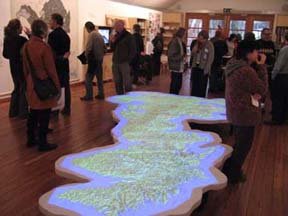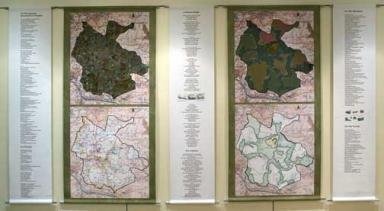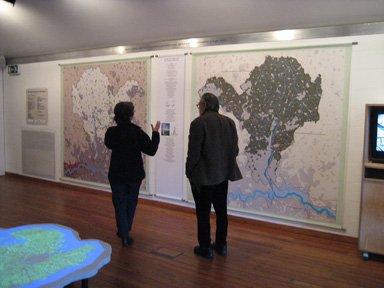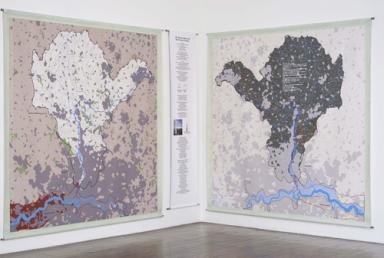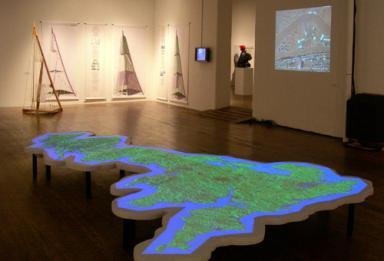Greenhouse Britain 2007-2009
Losing Ground, Gaining Wisdom
INSTALLATION, KNOWLE WEST MEDIA CENTER, 2008
INSTALLATION, CENTER FOR CONTEMPORARY ART AND NATURAL WORLD, 2007, COLLABORATION TYNDALL CENTER
INSTALLATION, RONALD FELDMAN FINE ARTS, 2009. COLLABORATION WITH UNIVERSITY OF SCHEFFIELD
LAND PLANNING GROUP
INSTALLATION VIEW OF ARCHITECTURAL SKETCH IN COLLABORATION WITH JOHN BIGNELL ARCHITECTS, BRISTOL, SHOWN AT CENTER FOR CONTEMPORARY ART AND NATURAL WORLD, 2007.
INSTALLATION VIEW OF LEA VALLEY, ON THE UPWARD MOVEMENT OF PEOPLE. WHERE THE TEXT EXPRESSES THE CARBON SEQUESTERED WHEN THE LEA VALLEY WATERSHED IS REFORESTED. RONALD FELDMAN, 2009
INSTALLATION SHOT, RONALD FELDMAN 2009
INSTALLATION, RONALD FELDMAN FINE ARTS, 2009. ON ECOCIVILITY AND STRUCTURE: A COLLABORATION. TEXT AND CONCEPT: HARRISON STUDIO. SYSTEM DESIGN AND STRUCTURE ATOPIA.
INSTALLATION, RONALD FELDMAN FINE ARTS, 2009. ON ECOCIVILITY AND STRUCTURE: A COLLABORATION. TEXT AND CONCEPT: HARRISON STUDIO. SYSTEM DESIGN AND STRUCTURE ATOPIA.
A work by Helen Mayer Harrison and Newton Harrison and the Harrison Studio & Associates Britain.
The installation addresses climate change from an artist’s perspective. The work proposes an alternative narrative about how people might withdraw as waters rise, what new forms of settlement might look like, and what content or properties a new landscape might have in response to the climate crisis. It also demonstrates how a city might be defended—not through fortification, but through ecological foresight.
The project treats mainland Britain as one ecosystem under stress. From estuary to upland, the work explores the interconnected systems of water, land, biodiversity, and human settlement. Rather than resist sea level rise, it proposes designing with it—withdrawing with grace and rebuilding with wisdom.
Part One: The Model and the Rising Waters
The installation is composed of a 13-foot-long model of the island of Britain. Six projectors above it animate the rivers and coastlines as waters rise in 2-meter increments, up to 16 meters. One key question guides the work: If the waters will rise with grace, how might we withdraw with equal grace?
A 10-minute three-voice audio narration begins with:
“The news is not good, and it’s getting worse...”
and ends with:
“...great changes are upon us as a culture, whether we will it or not, and great changes are upon all planetary life systems. And the news is really about how we meet these changes, and are transformed by them—or, in turn, transform them.”
Part Two: On the Upward Movement of People
A New Pennine Village
In collaboration with the Land Planning Group at Sheffield University, the design proposes a 9,000-person upland village. The surrounding land is ecosystemically redesigned to absorb the carbon footprint of the settlement through afforestation and meadowland restoration.
Part Three: In Defense of the City of Bristol
A three-minute video proposes a climate-resilient strategy for Bristol by rethinking the Avon River and Avon Gorge as part of a regenerative urban flood system.
Part Four: The Lea Valley and the Movement of Planning
In collaboration with APG Architects, this proposal critiques existing development in the Thames Estuary—shown submerged in the projected models—and instead reimagines the 1,000-square-mile Lea Valley watershed.
It proposes ecological redevelopment with high-rise housing on stilts, solar power, and hanging gardens for approximately one million people, while also enhancing London’s drinking water security.
Part Five: On Eco-Civility – The Vertical Promenade
In collaboration with ATOPIA, this segment explores how the social and civic virtues of a small-town high street can be translated into vertical living. The result is a 150-story, 5,000-person structure designed as a self-contained town where ecosystemic thinking shapes its architecture, culture, and economy.
Though part of Greenhouse Britain, this work also stands independently—as one in a serpentine sequence of structures envisioned for the Lea Valley.
Exhibition History
Greenhouse Britain was exhibited at eight venues across the UK and United States between 2007 and 2018:
Centre for Contemporary Art and the Natural World
London Wildlife Trust Annual Conference
Darwin Festival, Shrewsbury Museum & Art Gallery
Holden Gallery, Manchester Metropolitan University
Knowle West Media Centre, Bristol
City Hall, London
Ronald Feldman Fine Arts, New York (2009)
KALA Gallery, Berkeley (2009)
Coulter Gallery, Stanford University (2018)
The final UK presentation at City Hall, London posed a direct challenge to then newly elected Mayor Boris Johnson, inviting reflection on how governance might engage the climate crisis with ecological imagination.
Project Credits
When: 2006–2009
Where: Great Britain
Associate Artist: David Haley
Designer: Gabriel Harrison with Vera Westergaard
Producer: Chris Fremantle
Scientific Consultant: Dr. Robert Nicholls
Contributors: Professor Paul Selman & students from APG/AIM Architects
This project was funded by a DEFRA grant. Research on the Lea Valley was supported by a Bright Sparks grant.
Click Here to read the text “On Ecocivility and On Structure.”
The Pennine Village — A national-scale water-holding landscape responding to Britain’s upland ecosystems and water stress.

